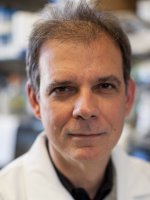Insights into microbial pathogenesis and immunology from Cryptococcus neoformans
to

Arturo Casadevall, M.D., Ph.D.
Professor and Chair
Albert Einstein College of Medicine
Dr. Casadevall’s major research interests are in fungal pathogenesis and the mechanism of antibody action. In the area of biodefense, he has an active research program to understand the mechanisms of antibody-mediated neutralization of Bacillus anthracis toxins. In recent years Dr. Casadevall has become interested in problems with the scientific enterprise and, with his collaborators, has shown that misconduct accounts for the majority of retracted publications. He has suggested a variety of reforms to the way science is done. He has served on numerous NIH committees including those that drafted the NIAID Strategic Plan and the Blue Ribbon Panel on Biodefense Research. He is currently a member of the National Science Advisory Board for Biosecurity and co-chairs the NIAID Board of Scientific counselors.
Summary
The majority of human pathogenic fungi are soil-dwelling microbes that have no obvious need for animal hosts. This raises a fundamental question in microbial pathogenesis: Why do some of these organisms cause disease in mammals? In this lecture we will dissect the biology of the human pathogenic fungus Cryptococcus neoformans in an effort to glean an explanation for the origin of virulence. C. neoformans, which causes lung infection in immune-compromised individuals, is an intracellular pathogen with a remarkable replicative strategy that includes the capacity for exciting the host cell without triggering its lysis. This process involves inflicting just enough damage to the host cell to interfere with its microbicidal properties without triggering cell-death pathways such that intracellular replication can proceed unhindered while the host cell remains alive to participate in the exit of fungal cells. The similarity in the interactions between cryptococcal cells with macrophages and amoeba has led to the proposal that the cells’ capacity for mammalian virulence emerged accidentally as a result of environmental interactions with phagocytic predators. In this lecture we will also explore the fascinating properties of melanin, an enigmatic pigment that performs a myriad of functions from enhancing cell-wall integrity to energy transduction. We will also consider some of the immunological lessons from studying C. neoformans, which produced important insights into novel antibody protective functions. Finally, we will look at the big picture of fungal pathogenesis and explore the concept of accidental virulence and the likelihood that global warming will bring new fungal diseases.
This page was last updated on Wednesday, August 11, 2021